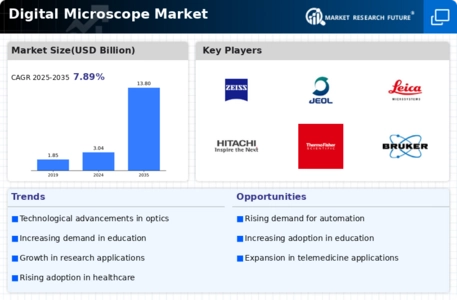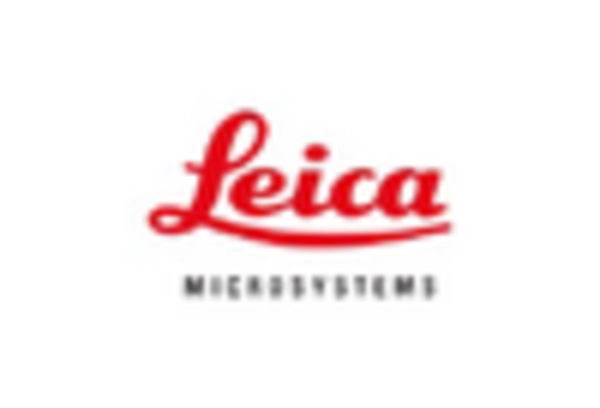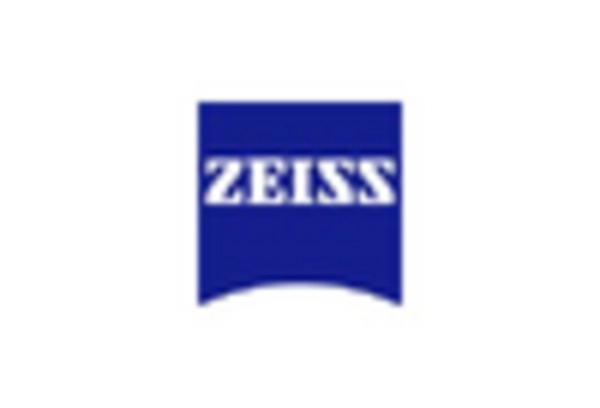Surge in Educational Institutions
The Digital Microscope Market is witnessing a surge in adoption within educational institutions, driven by the need for enhanced learning tools. Digital microscopes offer interactive and engaging ways for students to explore microscopic worlds, making them invaluable in biology and chemistry education. Many schools and universities are investing in digital microscopy to facilitate remote learning and hands-on experiences. Data suggests that the educational segment of the digital microscope market is expected to grow by approximately 6% annually, reflecting the increasing recognition of digital microscopes as essential educational resources. This trend highlights the pivotal role of digital microscopes in shaping the future of science education within the Digital Microscope Market.
Increased Adoption in Quality Control
Quality control processes in manufacturing and production are increasingly incorporating digital microscopes, thereby driving growth in the Digital Microscope Market. Industries such as electronics, automotive, and pharmaceuticals utilize digital microscopy for inspection and quality assurance. The ability to detect defects at a microscopic level ensures higher product quality and compliance with industry standards. Recent statistics indicate that the market for digital microscopes in quality control applications is expected to grow significantly, with a projected increase of around 7% annually. This trend underscores the critical role of digital microscopes in maintaining quality standards, further solidifying their importance in the Digital Microscope Market.
Integration of Artificial Intelligence
The integration of artificial intelligence (AI) into digital microscopy is transforming the Digital Microscope Market. AI technologies enhance image analysis, enabling faster and more accurate interpretations of microscopic images. This advancement is particularly beneficial in fields such as pathology and materials analysis, where precision is paramount. The market is witnessing a surge in AI-enabled digital microscopes, which are expected to account for a significant share of the market by 2026. The potential for AI to automate routine tasks and improve diagnostic accuracy suggests a promising future for the Digital Microscope Market, as it aligns with the broader trend of digital transformation in scientific research.
Growing Demand in Healthcare Diagnostics
The Digital Microscope Market is significantly influenced by the growing demand for advanced diagnostic tools in healthcare. Digital microscopes are increasingly utilized in clinical laboratories for histopathology and cytology, providing high-resolution images that aid in accurate diagnosis. The rise in chronic diseases and the need for early detection are propelling the adoption of digital microscopy in healthcare settings. Market analysis indicates that the healthcare segment is projected to expand at a rate of approximately 9% over the next few years, driven by technological advancements and the increasing emphasis on precision medicine. This growth underscores the vital role of digital microscopes in enhancing diagnostic capabilities within the Digital Microscope Market.
Rising Demand in Research and Development
The Digital Microscope Market is experiencing a notable increase in demand driven by the expanding research and development sectors across various fields. Institutions and laboratories are increasingly adopting digital microscopes for their ability to provide high-resolution imaging and advanced analytical capabilities. This trend is particularly evident in materials science and biology, where precise imaging is crucial. According to recent data, the market for digital microscopes in research applications is projected to grow at a compound annual growth rate of approximately 8% over the next five years. This growth is indicative of the increasing reliance on digital microscopy for innovative research, thereby propelling the Digital Microscope Market forward.


















Leave a Comment